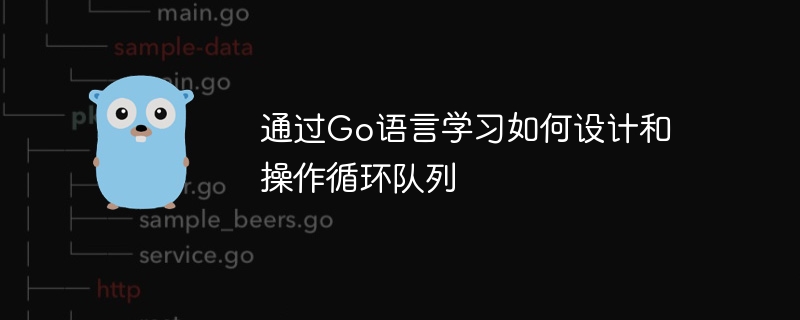透過Go語言學習如何設計和操作循環隊列

設計和操作循環佇列是資料結構中常見的問題,而透過使用Go語言編寫程式碼來學習這個概念將有助於理解循環佇列的工作原理和實作方法。在本文中,我們將深入探討循環隊列的概念和Go語言編寫循環隊列的具體範例。首先,我們來了解一下循環隊列的定義和操作。
循環隊列的定義和操作
循環隊列是一種環形的隊列資料結構,其基本特徵是隊列的頭和尾在邏輯上是相連的。當佇列尾部到達數組的末端時,如果佇列頭部仍有空間,就可以利用這部分空間,形成一個循環。
循環佇列常見的操作包括:
- 入隊(enqueue):向佇列尾部插入元素。
- 出隊(dequeue):從佇列頭部刪除元素。
- 判斷佇列是否為空。
- 判斷佇列是否已滿。
使用Go語言實作循環佇列
下面是使用Go語言實作循環佇列的程式碼範例:
package main
import "fmt"
type MyCircularQueue struct {
data []int
size int
front int
rear int
}
func Constructor(k int) MyCircularQueue {
return MyCircularQueue{
data: make([]int, k),
size: k,
front: 0,
rear: 0,
}
}
func (this *MyCircularQueue) EnQueue(value int) bool {
if this.IsFull() {
return false
}
this.data[this.rear] = value
this.rear = (this.rear + 1) % this.size
return true
}
func (this *MyCircularQueue) DeQueue() bool {
if this.IsEmpty() {
return false
}
this.front = (this.front + 1) % this.size
return true
}
func (this *MyCircularQueue) Front() int {
if this.IsEmpty() {
return -1
}
return this.data[this.front]
}
func (this *MyCircularQueue) Rear() int {
if this.IsEmpty() {
return -1
}
return this.data[(this.rear - 1 + this.size) % this.size]
}
func (this *MyCircularQueue) IsEmpty() bool {
return this.front == this.rear
}
func (this *MyCircularQueue) IsFull() bool {
return (this.rear + 1) % this.size == this.front
}
func main() {
obj := Constructor(3)
fmt.Println(obj.EnQueue(1)) // true
fmt.Println(obj.EnQueue(2)) // true
fmt.Println(obj.EnQueue(3)) // true
fmt.Println(obj.EnQueue(4)) // false
fmt.Println(obj.Rear()) // 3
fmt.Println(obj.IsFull()) // true
fmt.Println(obj.DeQueue()) // true
fmt.Println(obj.EnQueue(4)) // true
fmt.Println(obj.Rear()) // 4
}在這段程式碼中,我們定義了一個MyCircularQueue結構體,其中包含了循環佇列的資料和操作方法。透過建構函式Constructor初始化循環佇列,然後實作了入隊、出隊、判斷佇列是否為空、佇列是否已滿等方法。
透過這個範例,我們可以清楚地了解了使用Go語言如何設計和操作循環隊列,深入理解循環隊列的實作原理。希望這篇文章能對大家在學習循環隊列和Go語言程式設計中有所幫助。
以上是透過Go語言學習如何設計和操作循環隊列的詳細內容。更多資訊請關注PHP中文網其他相關文章!

熱AI工具

Undresser.AI Undress
人工智慧驅動的應用程序,用於創建逼真的裸體照片

AI Clothes Remover
用於從照片中去除衣服的線上人工智慧工具。

Undress AI Tool
免費脫衣圖片

Clothoff.io
AI脫衣器

Video Face Swap
使用我們完全免費的人工智慧換臉工具,輕鬆在任何影片中換臉!

熱門文章

熱工具

記事本++7.3.1
好用且免費的程式碼編輯器

SublimeText3漢化版
中文版,非常好用

禪工作室 13.0.1
強大的PHP整合開發環境

Dreamweaver CS6
視覺化網頁開發工具

SublimeText3 Mac版
神級程式碼編輯軟體(SublimeText3)
 Go語言中用於浮點數運算的庫有哪些?
Apr 02, 2025 pm 02:06 PM
Go語言中用於浮點數運算的庫有哪些?
Apr 02, 2025 pm 02:06 PM
Go語言中用於浮點數運算的庫介紹在Go語言(也稱為Golang)中,進行浮點數的加減乘除運算時,如何確保精度是�...
 Go的爬蟲Colly中Queue線程的問題是什麼?
Apr 02, 2025 pm 02:09 PM
Go的爬蟲Colly中Queue線程的問題是什麼?
Apr 02, 2025 pm 02:09 PM
Go爬蟲Colly中的Queue線程問題探討在使用Go語言的Colly爬蟲庫時,開發者常常會遇到關於線程和請求隊列的問題。 �...
 GoLand中自定義結構體標籤不顯示怎麼辦?
Apr 02, 2025 pm 05:09 PM
GoLand中自定義結構體標籤不顯示怎麼辦?
Apr 02, 2025 pm 05:09 PM
GoLand中自定義結構體標籤不顯示怎麼辦?在使用GoLand進行Go語言開發時,很多開發者會遇到自定義結構體標籤在�...
 在 Go 語言中,為什麼使用 Println 和 string() 函數打印字符串會出現不同的效果?
Apr 02, 2025 pm 02:03 PM
在 Go 語言中,為什麼使用 Println 和 string() 函數打印字符串會出現不同的效果?
Apr 02, 2025 pm 02:03 PM
Go語言中字符串打印的區別:使用Println與string()函數的效果差異在Go...
 在Go語言中使用Redis Stream實現消息隊列時,如何解決user_id類型轉換問題?
Apr 02, 2025 pm 04:54 PM
在Go語言中使用Redis Stream實現消息隊列時,如何解決user_id類型轉換問題?
Apr 02, 2025 pm 04:54 PM
Go語言中使用RedisStream實現消息隊列時類型轉換問題在使用Go語言與Redis...
 Go語言中`var`和`type`關鍵字定義結構體的區別是什麼?
Apr 02, 2025 pm 12:57 PM
Go語言中`var`和`type`關鍵字定義結構體的區別是什麼?
Apr 02, 2025 pm 12:57 PM
Go語言中結構體定義的兩種方式:var與type關鍵字的差異Go語言在定義結構體時,經常會看到兩種不同的寫法:一�...
 Go語言中哪些庫是由大公司開發或知名的開源項目提供的?
Apr 02, 2025 pm 04:12 PM
Go語言中哪些庫是由大公司開發或知名的開源項目提供的?
Apr 02, 2025 pm 04:12 PM
Go語言中哪些庫是大公司開發或知名開源項目?在使用Go語言進行編程時,開發者常常會遇到一些常見的需求,�...
 在Go編程中,如何正確管理Mysql和Redis的連接與釋放資源?
Apr 02, 2025 pm 05:03 PM
在Go編程中,如何正確管理Mysql和Redis的連接與釋放資源?
Apr 02, 2025 pm 05:03 PM
Go編程中的資源管理:Mysql和Redis的連接與釋放在學習Go編程過程中,如何正確管理資源,特別是與數據庫和緩存�...






